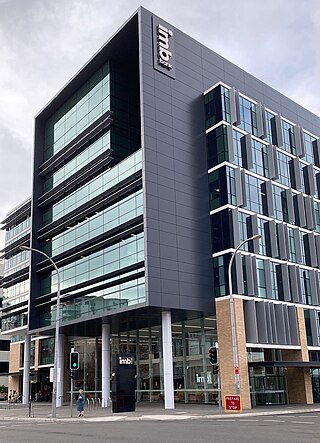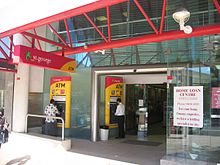
Bank of Baroda is an Indian public sector bank headquartered in Vadodara, Gujarat. It is the second largest public sector bank in India after State Bank of India, with 153 million customers, a total business of US$218 billion, and a global presence of 100 overseas offices. Based on 2019 data, it is ranked 1145 on Forbes Global 2000 list.

National Australia Bank is one of the four largest financial institutions in Australia in terms of market capitalisation, earnings and customers. NAB was ranked the world's 21st-largest bank measured by market capitalisation and 52nd-largest bank in the world as measured by total assets in 2019.

ANZ Bank New Zealand Limited is a New Zealand banking and financial services company, which operates as a subsidiary of Australia and New Zealand Banking Group Limited of Australia. ANZ is one of New Zealand's big four banks, and is the largest bank in New Zealand with approximately 30% of market share as of March 2021.

Bendigo and Adelaide Bank, is an Australian financial institution, operating primarily in retail banking. The company was formed by the merger of Bendigo Bank and Adelaide Bank in November 2007.

The Bank of Queensland (BOQ), formerly known as the Brisbane Permanent Benefit Building and Investment Society (BPBBIS) between 1874–1970, is an Australian retail bank with headquarters in Brisbane, Queensland. The bank is one of the oldest financial institutions in Queensland, having begun as a building society. It now has 111 owner-managed branches throughout Australia, including thirty-six corporate branches and third-party intermediaries. They also have over 2,300 ATMs.

BankSA, formerly known as the Bank of South Australia, the State Bank of South Australia and the Savings Bank of South Australia is the largest bank in South Australia. It is a subsidiary of Westpac.

The Australia and New Zealand Banking Group Limited (ANZ) is an Australian multinational banking and financial services company headquartered in Melbourne, Victoria. It is Australia's second-largest bank by assets and fourth-largest bank by market capitalisation.

The Bank of New South Wales (BNSW), also known commonly as The Wales, was the first bank in Australia, being established in Sydney in 1817 and situated on Broadway. During the 19th century, the bank opened branches throughout Australia and New Zealand, expanding into Oceania in the 20th century. It merged with many other financial institutions, finally merging with the Commercial Bank of Australia in 1982 and being renamed to the Westpac Banking Corporation on 4 May that year under the Bank of New South Wales Act 1982.
Banking in Australia is dominated by four major banks: Commonwealth Bank, Westpac, Australia & New Zealand Banking Group and National Australia Bank. There are several smaller banks with a presence throughout the country which includes Bendigo and Adelaide Bank, Suncorp Bank, and a large number of other financial institutions, such as credit unions, building societies and mutual banks, which provide limited banking-type services and are described as authorised deposit-taking institutions (ADIs). Many large foreign banks have a presence, but few have a retail banking presence. The central bank is the Reserve Bank of Australia (RBA). The Australian government’s Financial Claims Scheme (FCS) guarantees deposits up to $250,000 per account-holder per ADI in the event of the ADI failing.
Gail Kelly is a South African-born Australian businesswoman. In 2002, she became the first female CEO of a major Australian bank or top 15 company and in 2005 was the highest paid woman in an Australian corporation. She is the former chief executive officer (CEO) of Westpac, a role she held from 2008 to 2015. In 2010 Kelly was named 8th most powerful woman in the world by Forbes and as of 2014, she is listed in 56th place.
The Advance Bank was an Australian bank that existed from 1985 until 1997, when it merged with St George Bank. It is not related to Advance Bank AG of Germany.
The Savings Bank of South Australia was a bank founded in the colony of South Australia in 1848, based in Adelaide. In the early 20th century it established a presence in schools by setting up a special category of savings accounts for schoolchildren, and grew through the following decades.
Founded in 1921 as Australian Guarantee Company to initially provide finance for purchasers of smaller household items, it progressed into financing motor vehicles and was renamed as Australian Guarantee Corporation (AGC) in 1925. AGC was Australia's oldest national finance company offering a range of finance, investment and insurance products and were market leaders in equipment finance, cashflow finance, motor vehicle and personal finance.
The Bank of Melbourne is a financial institution operating in Victoria, Australia. A subsidiary of Westpac, it was commenced operations on 25 July 2011.

Westpac Banking Corporation, known simply as Westpac, is an Australian multinational banking and financial services company headquartered at Westpac Place in Sydney, New South Wales.

IMB Bank is an Australian mutual bank established in 1880. In 2020, IMB Bank was voted by Forbes as one of the World's Best Banks, and, in 2022, was found by financial services research company Canstar to have Australia's Most Satisfied Customers for both the Bank and Mutual Bank categories.

Groupe BPCE is a major French banking group formed by the 2009 merger of two major retail banking groups, Groupe Caisse d'Épargne and Groupe Banque Populaire. As of 2021, it was France's fourth largest bank, the seventh largest in Europe, and the nineteenth in the world by total assets. It has more than 8,200 branches nationwide under their respective brand names serving nearly 150 million customers. It is Europe's largest bank by revenue, ahead of BNP Paribas and HSBC. It is considered a global systemically important bank (G-SIB) by the Financial Stability Board.
The Bank of Melbourne is a financial institution based in Melbourne, Australia, established in 1989 and taken over by the Westpac Banking Corporation (Westpac) in 1997. In 2004, Westpac rebranded the Bank of Melbourne branches as Westpac branches. In 2011, Westpac resurrected the brand after rebranding its purchase of Bank of St George in Melbourne specifically and possibly in response to its initial closing of the brand.
Greater Bank is an Australian customer-owned bank and now a brand of Newcastle Greater Mutual Group, an organisation formed through the merger between Greater Bank and Newcastle Permanent Building Society.

ING Bank (Australia) Limited is a direct bank operating in Australia. It is a wholly owned subsidiary of the multinational Dutch bank, ING Group. ING Australia holds an Australian banking licence as a foreign subsidiary company.















